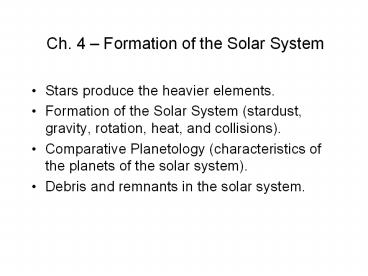Ch. 4 - PowerPoint PPT Presentation
1 / 34
Title:
Ch. 4
Description:
Ch. 4 Formation of the Solar System Stars produce the heavier elements. Formation of the Solar System (stardust, gravity, rotation, heat, and collisions). – PowerPoint PPT presentation
Number of Views:95
Avg rating:3.0/5.0
Title: Ch. 4
1
Ch. 4 Formation of the Solar System
- Stars produce the heavier elements.
- Formation of the Solar System (stardust, gravity,
rotation, heat, and collisions). - Comparative Planetology (characteristics of the
planets of the solar system). - Debris and remnants in the solar system.
2
- The heavy elements in the solar system were
formed in an earlier generation of stars - The early Universe contained only hydrogen,
helium, and traces of lithium. - All heavier elements were created in the core of
stars as they burned the hydrogen and helium
into carbon, oxygen, neon, calcium, magnesium,
silicon, and iron - These were then expelled into space by
- - stellar winds (happening with our sun now)
- - planetary nebulae (not planets, but similar
appearance to early astronomers) - see slides - - nova and supernova explosions (which also
create the heavier elements, including
radioactive elements)
3
Solar Prominence photo by SOHO spacecraft
The solar wind expels some heavy elements into
space.
from the Astronomy Picture of the Day site
4
Helium Shell Burning on the Horizontal
Branchprior to the formation of a planetary
nebula.
5
Planetary Nebulae form when the core cant reach
600 million K, the minimum needed for carbon
burning.
6
Another dramatic result of stellar evolution a
supernova remnant which expels heavy elements
into space.
7
A Dark Cloud dust and gas, dense enough to
block starlight.
8
Radio Emission reveals the dark dust cloud.
9
Horsehead Nebula (The neck is about 0.25 pc
across)A nice example of a dark dust cloud
10
Formation of the Solar System
There are several kinds of objects in our Solar
System Terrestrial planets Mercury, Venus,
Earth, and Mars Jovians the gas giants
Jupiter, Saturn, Uranus, and Neptune debris
asteroids, comets and meteoroids, and some
objects still being classified Kuiper Belt,
Oort cloud How did these form from interstellar
material?
11
Young Stars in OrionThis photo shows the
nebula in visible light.
12
Young Stars in OrionAn IR photo shows the
stars clearly, note the four bright stars, and
many others.
13
Orion NebulaA closer look reveals knots or
evaporating gaseous globules EGGs, some of
which may contain protostars.
14
These globulesmay contain evolving planets as
well as a central protostar.
15
Several disks that may be protoplanetary disks
are found after blowing up the Hubble photo to
look at smaller details.
16
- Major facts that any theory of solar-system
formation must explain - Each planet is relatively isolated in space.
- The orbits of the planets are nearly circular.
- The orbits of the planets all lie in nearly the
same plane. - Direction of planets movement in orbit is same
as suns rotation. - Direction of planets rotation is same as suns
rotation. (usually) - Direction of the various moons revolution is
same as planets rotation. - The planetary system is highly differentiated.
- Asteroids are very old, and not similar to
terrestrial planets or Jovian planets. - The Kuiper belt is a group of asteroid-sized icy
bodies orbiting outside the orbit of Neptune.
(KBO Kuiper Belt Objects) - The Oort Cloud is composed of icy cometary
objects that do not orbit in the same plane as
the planets (the ecliptic).
17
Angular Momentum influences the formation of
planetary disks during the collapse of a cloud
of gas
18
Beta Pictoris is one example of a
protoplanetary disk top false color image
with the central star blocked out to show the
diskbottom artists rendition of what the
disk might looklike if a planet is forming
19
Beta Pictoris has a protoplanetary disk and
a planet !This image is one of just a few
that directly shows a planet in orbit around a
star.
20
Conservation of Angular Momentum
21
Conservation of Angular Momentum in a figure
skater.
22
A Theory of Solar System Formation A
spinning gas cloud condenses to a much smaller
size, and begins to rotate much faster due to
conservation of angular momentum. This is the
protoplanetary disk, also called a
proplyd.This process explains the fact that
all the objects tend to rotate in the same way
(or sense) in a system.
23
Differentiation may be due to the temperatures in
the Early Solar NebulaThe inner solar system
is closer to the early Sun, and so it is hotter.
Volatile gases are not condensed on the planets
and end up condensing in the Jovian planets
further out. This is similar to a process in
chemical plants called distillation or
fractionation.
24
Sun and Planets (approximate scale of diameters)
25
Ch. 5 - Exoplanets
- Planets have been discovered orbiting other
stars. - Evidence from several sources
- - Distortion of protoplanetary disks (proplyds).
- - Doppler shift of the light of the star,
indicating radial velocity shifts. - - Astrometry to measure stellar wobble.
- - Detection of dimming of the star, indicating a
transit by a planet. (Most of them are found this
way.) - Over 3000 exoplanets have been found.
26
Beta Pictoris has a planet
27
(No Transcript)
28
(No Transcript)
29
Extra-solar Planets are revealed by the Doppler
effect, seen when we study the central star
30
(No Transcript)
31
(No Transcript)
32
Experimental methods have their own particular
bias. Doppler surveys find only the large
planets. Kepler transit studies have only found
short period planets.
33
Kepler has found many planets smaller than
Jupiter, so it is adding to the list of smaller
planets that Doppler measurements have not seen.
34
Earth-size planets with temperatures suitable for
life have been found by the Kepler spacecraft.

